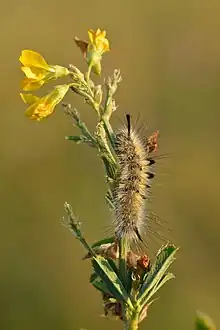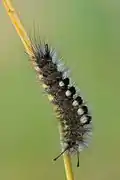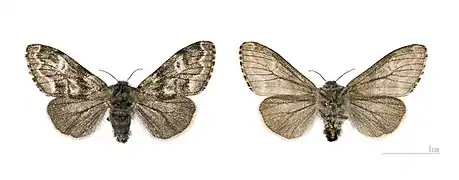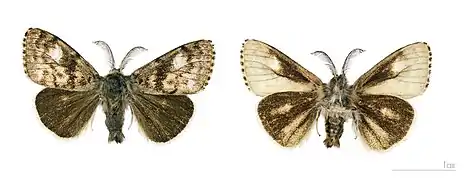Gynaephora selenitica
Gynaephora selenitica is a moth in the family Erebidae first described by Eugenius Johann Christoph Esper in 1789.[1] It is found from central Europe through eastern Europe to the Urals and Ob' River in West Siberia. It is not found in western and southern Europe and Scandinavia.[2]
| Gynaephora selenitica | |
|---|---|
 | |
| Scientific classification | |
| Domain: | Eukaryota |
| Kingdom: | Animalia |
| Phylum: | Arthropoda |
| Class: | Insecta |
| Order: | Lepidoptera |
| Superfamily: | Noctuoidea |
| Family: | Erebidae |
| Genus: | Gynaephora |
| Species: | G. selenitica |
| Binomial name | |
| Gynaephora selenitica (Esper, 1789) | |
| Synonyms | |
| |
The wingspan is 20–25 mm for males and 30–35 mm for females. Adults are on wing from May to June.
The larvae are polyphagous and feed mainly on Fabaceae species (including Lotus, Coronilla, Hippocrepis and Onobrychis), as well as various shrubs (Prunus spinosa, Salix, Vaccinium, Calluna and Rosa) and other plants (Asteraceae, Rosaceae including Potentilla). Larvae can be found from July to April. The species overwinters in the larval stage.[3]
 Caterpillar
Caterpillar Female
Female Male
Male
References
- Savela, Markku (July 2, 2019). "Gynaephora selenitica (Esper, 1789)". Lepidoptera and Some Other Life Forms. Retrieved March 27, 2020.
- "Gynaephora selenitica (Esper, 1789)". Fauna Europaea. Retrieved March 27, 2020.
- Schmetterlinge und ihre Ökologie (in German)
External links
Wikimedia Commons has media related to Gynaephora selenitica.
- "10394 Gynaephora selenitica (Esper, 1789) - Mondfleck-Bürstenspinner, Mondfleck-Bürstenbinder". Lepiforum e. V.
This article is issued from Wikipedia. The text is licensed under Creative Commons - Attribution - Sharealike. Additional terms may apply for the media files.